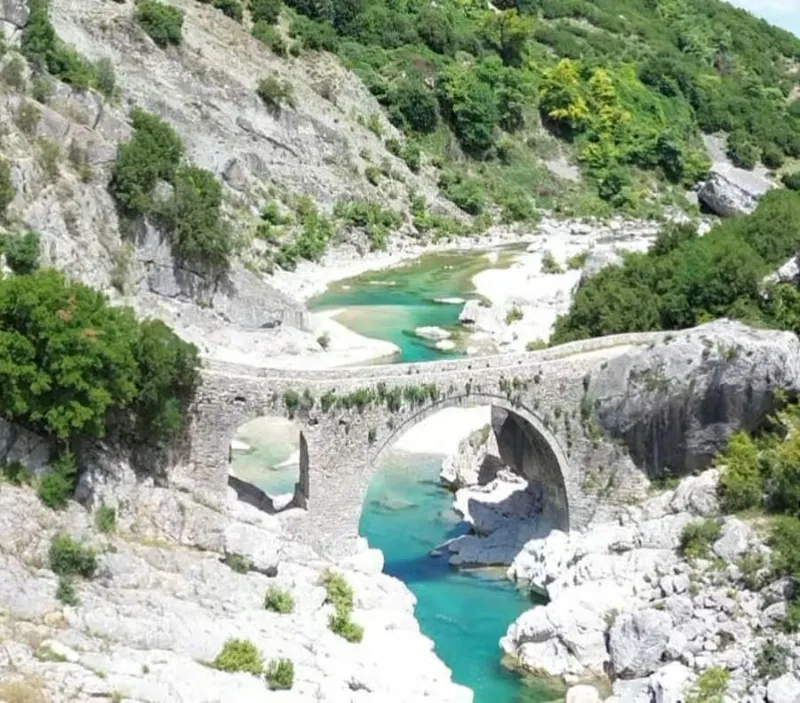Brataj Bridge is one of Albania’s most iconic landmarks, offering travelers a fascinating glimpse into the country’s rich history and architectural heritage. Spanning the picturesque Shushica River, this historic stone arch bridge not only represents the ingenuity of Ottoman-era engineering but also serves as a cultural symbol for the Brataj village and surrounding region. Whether you are a history enthusiast, an architecture lover, or a nature explorer, visiting Brataj Bridge promises an unforgettable experience along one of Albania’s most scenic spots near Vlora.
Brataj Bridge History
Brataj Bridge was constructed during the Ottoman era, likely in the 18th century, as a crucial crossing over the Shushica River. Its creation reflects the strategic importance of connecting villages and trade routes in southern Albania. Over the centuries, the bridge has not only facilitated local commerce but also become a testament to the skill and craftsmanship of the builders who designed stone arch bridges that could endure both natural and human-made challenges.
Ottoman-era bridges in Albania
Albania is home to a number of remarkable Ottoman-era bridges, yet Brataj Bridge stands out for its elegance and durability. Like other historic bridges in the region, it was built with locally sourced stone, carefully shaped and arranged to form a series of arches capable of supporting both foot traffic and pack animals. Compared to similar structures in Berat or Gjirokastër, Brataj Bridge’s integration with its natural surroundings gives it a distinctive charm that continues to attract historians, photographers, and tourists alike.
Importance in local history
Brataj Bridge played a significant role in connecting communities in southern Albania. For centuries, it served as a vital passage for villagers transporting goods, livestock, and agricultural products. Beyond its practical function, the bridge became a cultural landmark, often mentioned in local folklore and stories that highlight its endurance through floods, seasonal changes, and historical events. Today, it is recognized as one of the Albanian cultural monuments, preserving a tangible link to the past and offering insight into the region’s social and economic history.
Why visit:
- Walk along a centuries-old Ottoman-era structure.
- Capture photographs of the stone arches framed by natural scenery.
- Explore Brataj village and learn about its historical significance.
Brataj Bridge Architecture
Stone arch bridges in Albania
Brataj Bridge is an excellent example of stone arch bridge architecture, a common construction style during the Ottoman period. Its design showcases precision engineering, where each stone was carefully cut and placed to form arches that distribute weight evenly. This method allowed bridges like Brataj to withstand centuries of wear, seasonal floods, and environmental pressures, making it a lasting feature of Albania’s historical landscape.
The bridge features three elegant arches that gracefully span the Shushica River. These arches not only provide structural stability but also create a visually appealing rhythm that draws the eye across the flowing waters below. Each arch demonstrates the attention to detail and architectural knowledge of the builders, highlighting the ingenuity of Ottoman construction techniques.
Architectural significance
Brataj Bridge is more than just a crossing; it is a cultural and architectural treasure. Its construction combines functionality with artistry, reflecting the aesthetic sensibilities of its era. Unlike modern bridges, which often prioritize speed and efficiency, historic stone bridges like Brataj emphasize harmony with the environment, blending seamlessly with the surrounding landscape. For tourists and architecture enthusiasts, this makes it a perfect destination to study traditional engineering while enjoying the serene beauty of the Shushica River valley.
Visitor highlights:
- Observe the skillful stonework and traditional construction techniques.
- Experience a bridge that balances engineering, aesthetics, and natural surroundings.
- Appreciate why Brataj Bridge is recognized as an Albanian cultural monument.
Brataj Village and Surroundings
Brataj Bridge is located in the charming village of Brataj, nestled in the southern part of Albania near the city of Vlora. The bridge spans the Shushica River, a serene waterway surrounded by rolling hills and lush greenery. Its location makes it an ideal destination for travelers looking to combine cultural exploration with natural beauty. For visitors coming from Vlora, the bridge is approximately a 30–40 minute drive, offering a peaceful retreat from the bustling city and a chance to experience authentic rural Albania.
Scenic spots near Vlora
The region surrounding Brataj Bridge is filled with breathtaking landscapes that appeal to both photographers and nature enthusiasts. As you approach the bridge, you’ll notice the river meandering through a valley framed by hills dotted with olive groves and small farms. Nearby, there are additional scenic spots worth visiting:
- Llogara Pass viewpoints – Panoramic views of the Ionian coastline.
- Vjosa River valleys – Perfect for riverside walks and birdwatching.
- Local village squares – Experience traditional Albanian architecture and hospitality.
These areas provide ample opportunities to pause, take photos, and enjoy the quiet beauty of southern Albania before or after crossing Brataj Bridge.
Brataj Bridge walking routes
Exploring Brataj Bridge on foot is a highly recommended way to absorb its history and surroundings. There are several walking routes to consider:
- Short riverside stroll – A gentle 15–20 minute walk along the Shushica River, perfect for families or casual visitors.
- Village loop – A 1–2 hour route that circles the village of Brataj, passing by the bridge, traditional homes, and small local markets.
- Extended scenic hike – For more adventurous visitors, a 3–4 hour hike connects Brataj Bridge with nearby hills, offering panoramic views of the valley and Shushica River.
Walking these routes allows travelers to engage with the landscape, discover hidden corners of the village, and capture unforgettable photographs of the historic bridge from multiple angles.
Tourist tips:
- Bring comfortable shoes for walking on uneven paths.
- Visit in spring or early autumn for mild weather and vibrant natural colors.
- Consider booking a local guide to learn about the bridge’s history and village traditions.
Tourism Brataj Bridge
Yes! Brataj Bridge is fully accessible to visitors and remains a popular destination for cultural and eco-tourism. While the bridge itself is preserved as a historical monument, the surrounding area is open for walking, photography, and leisurely exploration. It’s an excellent spot for tourists seeking an authentic Albanian experience off the beaten path.
Traveling from Vlora to Brataj Bridge is simple and convenient:
– By car: Approximately 30–40 minutes via SH8 and local village roads. Parking is available near the bridge.
– By taxi or private transfer: Ideal for visitors seeking a hassle-free trip.
– Guided tours: Albaniaturism.com offers curated tours that include transportation, a local guide, and opportunities to explore nearby villages and natural attractions.
Before heading to Brataj Bridge, travelers should keep a few things in mind:
– Weather: The area can be warm in summer and cool in early spring; bring appropriate clothing.
– Footwear: Comfortable walking shoes are recommended due to uneven stone paths.
– Photography: Early morning or late afternoon provides the best light for capturing the bridge and surrounding landscape.
– Local etiquette: Respect village customs and private property along walking routes.
Visiting Brataj Bridge is not only about seeing a historical structure but also about immersing yourself in Albania’s rural charm, enjoying scenic walks, and discovering cultural gems in the surrounding region.
Why is Brataj Bridge Important Culturally?
Albanian cultural monuments
Brataj Bridge is recognized as an important Albanian cultural monument, preserving the architectural and historical legacy of the Ottoman era. Its stone arches, careful craftsmanship, and integration into the natural landscape make it more than just a bridge—it is a symbol of Albania’s enduring heritage. For historians and cultural tourists alike, the bridge offers a tangible connection to the region’s past, highlighting how infrastructure played a vital role in shaping local communities.
Role in local tourism
Today, Brataj Bridge attracts both domestic and international visitors, contributing to the cultural tourism of the Vlora region. Local guides often include the bridge in walking tours, allowing travelers to learn about the history, architecture, and traditions of Brataj village. Festivals and cultural events in the surrounding area occasionally feature the bridge as a scenic backdrop, further cementing its role as a focal point of community life.
Nearby attractions to visit with Brataj Bridge
Tourists visiting Brataj Bridge can easily combine their trip with other notable sites in the region:
- Llogara National Park: Stunning mountain passes and panoramic views.
- Vjosa River valley: Perfect for riverside hikes and photography.
- Traditional villages near Vlora: Experience authentic Albanian village life, local cuisine, and handicrafts.
- Historic churches and small Ottoman-era structures: Adding context to the architectural style of Brataj Bridge.
By planning a multi-stop trip, visitors can maximize their experience, enjoying both cultural insights and natural beauty in a single itinerary.
Brataj Bridge Visitor Guide
Best time to visit Brataj Bridge
The ideal time to explore Brataj Bridge is during spring (April–June) and early autumn (September–October) when temperatures are mild and the natural scenery is at its most vibrant. Early mornings or late afternoons provide the best light for photography, casting warm tones on the stone arches and reflecting beautifully on the Shushica River.
Suggested itineraries
Visitors can customize their experience depending on their time and interests:
- Half-day trip: Walk along the Shushica River, explore the bridge, and visit Brataj village.
- Full-day itinerary: Combine Brataj Bridge with nearby scenic spots, traditional villages, and short hikes in the surrounding hills.
- Guided tours: Opt for a guided package with Albaniaturism.com to get historical context, insider stories, and transportation included.
Costs and booking tips
Visiting Brataj Bridge is generally free for independent travelers, but guided tours may include additional costs:
- Private tours: Starting from €40 per person, including transportation from Vlora.
- Group tours: Starting from €25 per person, perfect for families or friends.
- Booking in advance: Recommended during peak season to secure a guide and plan multi-site visits efficiently.
Visitor tips:
- Bring water, snacks, and a camera.
- Wear comfortable shoes for uneven terrain.
- Respect the bridge’s historic structure and local property.


0 Comment